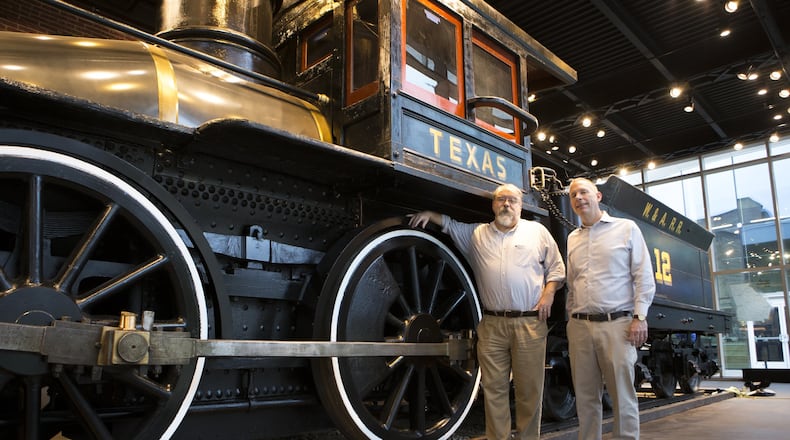On a chilly December afternoon three years ago, the 26-ton locomotive Texas swung into the sky above Grant Park, hoisted aloft by a mighty crane.
Sheffield Hale, president and CEO of the Atlanta History Center, was among the hardy witnesses to the surreal moment. As the Texas moved through the air, Hale spoke, almost with reverence, about the significance of this colossal artifact.
“It is an existential object,” said Hale, bundled against the cold. “That engine is why we’re here.”
Hale was speaking poetically, metaphorically, but also truthfully. Atlanta exists because of the Western & Atlantic Railroad, and of the locomotives that puffed up and down those rails from Atlanta to the Tennessee River, only two survive.
The Texas is one. Crane operators maneuvered the Texas onto a lowboy truck that day, which took it to a North Carolina beauty parlor for a makeover.
After a half-million-dollar restoration, this handsome machine, dressed to the nines, has been installed in a glass-front display case above West Paces Ferry Road, lit up at night like a Fifth Avenue Christmas storefront.
On Nov. 17 the public will be invited to see the sparkling reincarnation of the Texas, the centerpiece of a new permanent exhibit at the History Center called "Locomotion: Railroads and the Making of Atlanta."
“This will tell the story of Atlanta as a railroad city,” said Jackson McQuigg, vice president of operations at the History Center, as he recently walked alongside the locomotive in its new transparent home.
The 2,000-square-foot Rollins Gallery, built to show off the locomotive, is part of the booming growth at the center since 2014.
That was when the city of Atlanta entered into a 75-year deal with the center to care for and display the Texas and the massive panoramic painting, "The Battle of Atlanta." Both painting and locomotive had been displayed in the aging Cyclorama building in Grant Park since the 1920s.
Frantic construction ensued. Today, in addition to the Rollins Gallery, the campus boasts the new Lloyd and Mary Ann Whitaker Cyclorama Building, where the painting is also being painstakingly restored. It will go on display in February 2019.
A famous engine
Scores of locomotives pulled passengers and freight along the W&A lines between Atlanta and Chattanooga, but only the General and the Texas remain, saved from the scrapheap by their notoriety. The rest? “They’ve all been turned into razor blades,” said McQuigg.
The pair were part of the Great Locomotive Chase, a daring raid by Union forces intended to cripple the W&A Railroad, a critical artery for the Confederacy.
On April 12, 1862, federal spies led by civilian scout James J. Andrews crept behind enemy lines in North Georgia, spent the night in Marietta, hijacked the General at Big Shanty (now Kennesaw) and steamed north, attempting to wreak havoc as they traveled.
They were pursued by the General’s conductor, William Allen Fuller, and two others, who chased the General on foot, and then in a hand car. Surprisingly, Fuller was almost able to keep up with Andrews — trains were slow, grades were steep, and Andrews had to wait on sidings in several places to avoid southbound trains.
Fuller commandeered several trains in the pursuit, finally boarding the southbound Texas near Calhoun, and racing it backward toward Chattanooga in hot pursuit. Andrews ran out of fuel just north of Ringgold and abandoned the General there, as he and his party scattered into the woods.
The story has been made into a movie twice, once by Buster Keaton, once by Disney, and is also a highlight of the Southern Museum of Civil War and Locomotive History, in Kennesaw, the place where the whole adventure began. The railroad museum displays the General, the only other Civil War-era locomotive from the W&A to survive.
The Texas is important to the History Center because it is a physical embodiment of the forces that created and built Atlanta. Atlanta didn’t exist until 1837, when a W&A surveyor drove a spike into the ground in a forest near Hardy Ivy’s home, and declared it the zero mile mark, the southern terminus of the rail line. Hence, Atlanta’s original name, Terminus.
The railroad determined where Atlanta would begin. Rail traffic then accounted for the rapid growth of the hamlet, poised at the crossroads where the Georgia Railroad met the W&A. “This is Atlanta’s creation story,” said McQuigg.
The Texas continued in service long after the Civil War, until it was parked on a siding in 1907 to slowly rust in the rain. A group of citizens rescued the engine, donated it to the city and transported it to Grant Park, where it was displayed outdoors for about 16 years. This was better than the scrapheap, but the weather was still tough on the engine. Its fortunes improved when it was moved into the basement of the Cyclorama building in 1927.
Also part of the Atlanta History's new exhibit is the 7-foot-5-inch marble column called the Zero Mile Post, which memorialized in zero-mile mark in the 1850s. The location of the post, in what is called the Gulch, slipped into obscurity. The post has been sheltered inside a building constructed around it, but that building has been locked and unoccupied for the past 20 years.
This spring the Georgia Building Authority announced the building was to be demolished. so plans were made for it to be relocated to the History Center as part of the Texas exhibit.
Preservationists were alarmed that the post was moved, but Steve Stancil of the Georgia Building Authority told the AJC, “We gave Atlanta History Center a license and a license can be revoked at any time.”
The look of the Texas
The Texas is a classic 4-4-0 design, which indicates the locomotive was constructed with four leading wheels, four driving wheels and zero trailing wheels.
The design became a standard, called “the American type,” and an image of a 4-4-0 locomotive was part of the original seal of the city of Atlanta.
During restoration the train received a new smokestack, a new boiler jacket and a new cow-catcher, which, incidentally, was employed to catch things other than four-footed bovines. “Trees, snow, whatever else might come along,” said McQuigg.” The 19-foot tender that accompanies the Texas was also thoroughly renovated, with new timbers for its wooden frame.
The Texas had gaudy red and gold accents during its time in Grant Park, but its current uniform is mostly black.
McQuigg said the interpretive materials in the exhibit will tell “the history of railroaders, from Georgia and elsewhere. It will tell about the repair shops, the Pullman shops and other industries that grew up here. It will talk about how it’s no coincidence that we became the center of highways, and the center of air travel.
“This engine, that has been at times forgotten in its long lifetime, is going to become a focal point.” said McQuigg.
EVENT PREVIEW
'Locomotion: Railroads and the Making of Atlanta.' Opens Nov. 17. 10 a.m.-5:30 p.m. Monday-Saturday, noon-5:30 p.m. Sunday. $21.50-$9. Ticket sales end at 4:30 pm daily. Atlanta History Center, 130 W. Paces Ferry Road, Atlanta. 404-814-4000, www.atlantahistorycenter.com.
About the Author
The Latest
Featured







